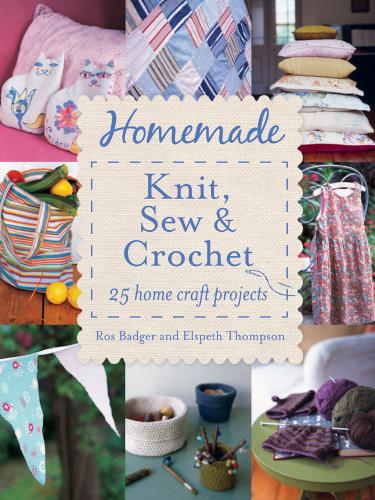The increasing number of books, blogs and websites that have appeared over the last couple of years extolling the virtues of all things homemade give me hope that this wonderful trend is here to stay.
Ros Badger
iPod cover
Precious iPods look even better tucked inside gorgeous homemade covers. This pattern is simple enough for novice knitters, and can be customised by varying the colour or design in subtle or bold ways.
You will need
4-ply cotton, approximately 10g (½oz) (we used mercerised cotton, which has a slight sheen and washes well)
2.75mm (UK size 12; US size 2) knitting needles
2.5mm crochet hook (if making optional strap)
Tension over stocking stitch
16sts and 22 rows = 5cm (2in)
Measurements
7 × 8.5cm (2¾ × 3½in)
To make an iPod Nano cover
• With 2.75mm (UK size 12; US size 2) needles and the 4-ply cotton, cast on 22sts and work 8 rows in garter st (knit every row) then work in stocking st (knit one row, purl one row) until the cover measures 15cm (6in).
• Work 8 rows garter st and cast off.
• Fold the bag in half, right sides together, sew the two side seams and then turn through.
To make an iPod classic or other MP3 player cover
• Measure your player and, using the tension guide, work out how many sts you need for the width, then add 4 more sts.
• With 2.75mm (UK size 12; US size 2) needles, cast on the required number of sts and work 8 rows garter st, then work in stocking st until the piece measures twice the length of your player. Work 8 more rows of garter st and cast off. Fold the bag in half, right sides together, sew the two side seams and then turn through.
To make the strap
The simplest way to make a strap is to attach a colourful piece of ribbon. However, if you know how to crochet, the following instructions explain how to make a strong, pretty strap.
• With the 2.5mm crochet hook and 4-ply cotton, make a 30cm (12in) long single chain.
• Thread this through the knitted bag just below the garter st top. There is no need to make eyelet holes as the chain can easily be threaded through between the knitted sts. Tie together the loose ends to make a loop.
Tea cosy
As well as keeping your tea hot, a homemade tea cosy brings an air of warmth and originality to the kitchen table. Choose colours that work with your cups and kitchen décor.
You will need
About 60g (2¼oz) yarn (this was knitted using Aran tweed but any Aran yarn would also work)
Yarn scraps in contrasting colours for the embroidery and pompom
4.5mm (UK size 7; US size 7) needles (you can change the needle size to make the cosy larger or smaller; the one pictured fits a six-teacup teapot)
Tension
10sts and 12 rows = 5cm (2in)
To make
• With 4.5mm (UK size 7; US size 7) needles and yarn, cast on 84sts and work 5 rows to form the border.
Row 1: Knit.
Row 2: Purl.
Repeat these 2 rows once more then divide (work for spout and handle).
Row 5: K42 and keep remaining sts on a stitch holder.
Row 6: K2, p38, k2.
Repeat the last 2 rows 10 times more, ending on a purl row. Keep these sts on a stitch holder and repeat on the opposite side until the work measures the same front and back. End on a purl row.
Next row: Knit across the whole work.
Next row: Purl.
Then start decreasing as follows:
Row 1: K11, k2tog, * k12, k2tog *, repeat from * to * 5 times, k1. (78sts)
Row 2: Purl.
Row 3: K10, k2tog, * k11, k2tog*, repeat from * to * 5 times, k1. (72sts)
Row 4: Purl.
Row 5: K9, k2tog, * k10, k2tog*, repeat from * to * 5 times, k1. (66sts)
Row 6: Purl.
Row 7: K8, k2tog, * k9, k2tog*, repeat from * to * 5 times, k1. (60sts)
Row 8: Purl.
Row 9: K7, k2tog, * k8, k2tog*, repeat from * to * 5 times, k1. (54sts)
Row 10: Purl.
Row 11: K6, k2tog, * k7, k2tog*, repeat from * to * 5 times, k1. (48sts)
Row 12: Purl.
Row 13: K1, k2tog across work to the last st, k1. 27sts remain.
• Cut your thread and then thread it through all the sts, pulling it tightly.
• Use this thread to sew the side seam as far as the opening for the spout, where the 2-st garter st edging finishes.
• Sew the bottom side seam to where the 2-st garter st edging begins.
• Work your motif (here, a teacup; see pattern) using chain st and a contrasting colour of wool.
• Tack the shape first, if you like, working out from the centre of the tea cosy to ensure the motif is central. Work a box in running st around the image in a contrasting colour of wool.
• Make a pompom and attach securely to the top.
